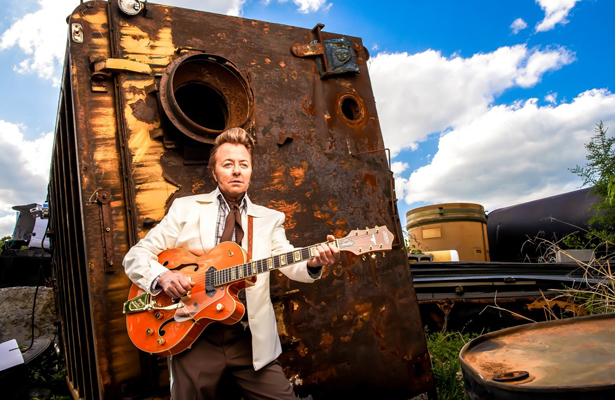
By Alan Sculley
Brian Setzer is a familiar face and name to most. Back in 1979 he fronted the rockabilly band The Tomcats before heading to London and soon the band became known as the Stray Cats. The new name came about as a suggestion from bassist Lee Rocker since at that point they were living as ‘strays.’ By the mid-80s the Stray Cats were a household name in America and found success with their album Built for Speed which yielded two Top 10 hits “Rock This Town” and “Stray Cat Strut.” In the 90s, Setzer formed The Brian Setzer Orchestra and his Christmas albums and tours became immensely popular. Setzer and his orchestra are still rocking it and touring. Be sure to catch their performance at the Allen Event Center on Dec. 11.
It’s been 10 years since Brian Setzer released a holiday album, but he’s broken the streak with the October release of Rockin’ Rudolph.
Recorded with his 18-piece “orchestra,” the new album features 12 songs consisting mostly of Christmas classics re-imagined in Setzer’s distinctive swinging big-band-with-a-bit-of-rockabilly style.
Despite the long gap between holiday albums, it’s not like Rockin’ Rudolph was part of any predetermined plan or any urgency Setzer felt to resume his series of Christmas albums.
“I don’t know, the bug just bit me,” Setzer said in a recent interview, suggesting how spontaneously the idea of making the album germinated. “What happened was I did that version of ‘Rudolph the Red Nosed Reindeer’ (retitled “Rockabilly Rudolph” on the album). I was fooling around at a sound check and I started playing that E minor riff and I started singing ‘Rudolph the red nosed reindeer’ in that minor key. That’s how all this stuff starts. It always starts with my guitar riff, and rockabilly is my springboard. That’s always where I jump off of. And I thought ‘Oh that’s cool. No one’s ever done that.
“ ‘Rudolph the Red Nosed Reindeer’ is a nice little kind of country song. I’ll make it rockabilly, you know, Rudolph’s got an attitude now. Those things snowballed and all of a sudden I kept writing and kept writing and going ‘Wow, this is cool.’ Then you’ve got a song.”
Setzer, who came to fame when his rockabilly trio, the Stray Cats, scored a major hit with their 1982 album, Built for Speed, soon started thinking about what other holiday songs might be ripe for reinvention.
He found there were plenty of classic Christmas songs he had yet to try adapting to the big band format.
Before he was done, Setzer’s selections included an instrumental take on “Hark, The Herald Angels Sing” with some serious swing, a tastefully rocked up “Carol of the Bells,” a jazzy and brassy “The Most Wonderful Time of the Year” and a version of “Here Comes Santa Claus” that could be called “jazzabilly.” He and the orchestra also turned “Joy To The World” into a vibrant instrumental romp that got renamed “Swingin’ Joy” and crafted a snazzy girl group-styled version of the wintertime standard “Little Jack Frost.”
But perhaps the most creative song on the album is a reworking of the theme song from the cartoon series, The Flintstones. It has new holiday season lyrics and new title, “Yabba-Dabba Yuletide.”
Like “Rockabilly Rudolph,” the idea for the song came out of nowhere.
“I was in Paris, jet lagged, laying up in bed at three o’clock in the morning. I was wide awake,” Setzer said. “And I don’t know how these things happen. I call it the little song bird, he came to visit. And I started singing (The Flintstones signature melody) in the middle of summer, laying in bed, ‘Merry, merry Christmas/and a happy holiday to you.’ I don’t know why that came into my head. And I said ‘Oh man, that’s so catchy.’
“Because The Flintstones theme is a piece of jazz. It’s a beautiful little written thing. And it’s a hit. Everybody knows it. So I said I’ve got to stay up and finish that, and I wrote all those words.”
The songs on Rockin’ Rudolph give Setzer and his full orchestra – expanded to 18 members with the addition of piano – some fresh songs to play on their annual holiday tour. As in past years, this year’s show figures to be pretty evenly split between Christmas songs and material from Setzer’s various non-seasonal catalog, going back to the Stray Cats.
Adding a third album of Christmas songs is making it harder than ever for Setzer to settle on a set list.
“Yikes, it gets hard because I change it (the set list) every year, but I have to add new songs,” he said. “It’s so hard to drop things out because I can’t drop out ‘Rock This Town’ and ‘Jingle Bells.’ I’ve got to play those and ‘Stray Cat Strut,’ and I’ve got to play ‘Rockin’ Around The Christmas Tree.’ ”
Setzer fans know that whatever songs make the set, they’ll have a rousing good time at his shows. That seems obvious now. But success was hardly a sure thing when the singer/guitarist decided to form the Brian Setzer Orchestra.
https://www.youtube.com/watch?v=orFGGJToqlI
By the early 1990s, Setzer had moved on from the Stray Cats after the trio reunited for the underrated 1992 album, Choo Choo Hot Fish. In between stints with the Stray Cats, Setzer had made a pair of well-received solo albums in the latter half of the 80s.
Then he arrived at the idea of putting together his twist on the 1940s/1950s big band sound, forming a horn-accented 17-piece ensemble, with his electric guitar moving from its traditional big band role as a background rhythm instrument into the spotlight as the centerpiece of the Brian Setzer Orchestra sound.
A self-titled album was released in 1994, followed by Guitar Slinger in 1996.
Then the third album, 1998’s The Dirty Boogie, broke the Brian Setzer Orchestra into the mainstream. The album went top 10 behind the popular cover of the Louis Prima classic, “Jump, Jive and Wail.”
Considering the timing and the expense of taking such a large ensemble on the road, Setzer feels he beat the odds with the orchestra.
“There’s no way it should have worked. There’s no way,” Setzer said. “You gotta think about taking a big band out (on tour), what was popular in ’93? Grunge, it was Kurt Cobain. I mean, there’s no way that thing should have gotten off the ground, especially with 17 people. It’s ridiculous. I just knew it was so good musically.
“It was like a toddler wobbling, come on, you can make it,” he said. “And it just kept growing and growing. Slowly, it kept getting bigger and bigger. Every time I brought it out, more people came.”
Then a few years later, the Brian Setzer Orchestra started building a lucrative niche with Christmas music. But it’s not like entering the Christmas market was some calculated business plan.
It all began with a call from the producers of the Arnold Schwarzenegger movie, Jingle All The Way.
“The producers had called me up and said ‘Hey, Brian, would you take a stab at doing ‘Jingle Bells’ with the big band?’ ” Setzer explained. “And I thought ‘Yeah, hell yeah.’ It’s a jump blues song. It’s just a blues song. So I’ll make that my own and I’ll give it back to you. So I did it and they loved it. And just for that movie alone, I think I did four tracks. I did one with Lou Rawls, I did one with Darlene Love. They kept asking me to do another.”
Setzer picked up from there with the first holiday album with the orchestra, 2002’s Boogie Woogie Christmas, followed by Dig That Crazy Christmas in 2005. Along the way, the Brian Setzer Orchestra launched its first tour and has been making the tours an annual tradition for a dozen years.
Setzer is more than happy to be able to take the orchestra on the road each holiday season.
“I love that tour. I hope that never goes away,” he said. “Not only is it profitable and everybody gets a good paycheck, but it’s just a beautiful sound. People light up. When I see people out on my Christmas tour, they’re so happy we’re back. They love it.”




